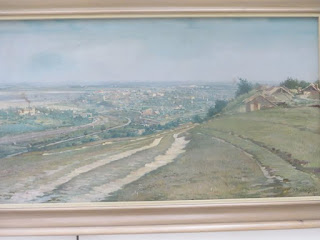 Sofia
detained us for a week and we decided to have a leisurely return (to
Bucharest) taking the middle of the three routes which sprout east from Sofia – the
quietest and probably most scenic which skirts the edge of the Stara Planina
(otherwise known as Blue Mountains).
Sofia
detained us for a week and we decided to have a leisurely return (to
Bucharest) taking the middle of the three routes which sprout east from Sofia – the
quietest and probably most scenic which skirts the edge of the Stara Planina
(otherwise known as Blue Mountains).
I had
forgotten that this is the road which offers access to the beautiful 19th
century village of Koprovichitsa (which
played such an important role in the 1870s uprising against the Turks) and had
no hesitation in veering right to see it again…..my third visit in the past
few years….(the first had been in winter; the second in autumn 2013) .The wood carvings on the doors and ceilings remind me of what an art form wood can be......RIP Bogdan......
Dare I wonder that the sermons possibly played a role in the 19th century liberation??????
Dare I wonder that the sermons possibly played a role in the 19th century liberation??????
Karlovo and Kazanluk
were on the schedule – the first to check whether any traces were left of the
peaceful courtyards of the 1930s which Nicola Tanev painted so evocatively;
Kazanluk, the heart of the rose valley, for possibly another visit to the
municipal gallery which keeps the heart of the Bulgarian painting beating. More
than 100 well-known artists grew up in this small town……
 We spotted
only a couple of remnants of former architectural splendours in Karlovo - and a sign
for the Chateau Copsa winery soon
had me distracted from thoughts of art galleries…..
We spotted
only a couple of remnants of former architectural splendours in Karlovo - and a sign
for the Chateau Copsa winery soon
had me distracted from thoughts of art galleries…..
Standing
alone in the vineyards stretching to the horizon with the Blue Mountains
towering above, the Chateau is a tastefully-created and designed modern building
which offers not only wine-tasting and meals but accommodation and sauna….Two
superb whites and two great roses were soon trickling down our throats –
tempered with chunks of cheeses, walnuts and dried plums…..all for 6 euros
apiece……one of the most delightful lunches we’ve had in some time………
And there
was still a couple of hundred kilometres to go before we reached our evening
destination – Russe – over the
mountains to Veliko Tarnovo and then the final 100 kms….most of it by now
thoroughly familiar.
We pulled in
just after 18.00 to the fascinating Luliaka
Hotel plum on the Danube but just within Russe’s boundaries.
It’s rare for a hotel to attract my loyalty but I so loved the layout, atmosphere and quiet beauty of the site that I quickly booked a second night…… Their meals and house rose (from their own winery) were an added attraction which will draw me whenever I feel I need a restover on my way back from Sofia…..
It’s rare for a hotel to attract my loyalty but I so loved the layout, atmosphere and quiet beauty of the site that I quickly booked a second night…… Their meals and house rose (from their own winery) were an added attraction which will draw me whenever I feel I need a restover on my way back from Sofia…..
And Russe
has so many attractions – particularly, for us, the early 20th
century buildings….I had been looking for the Canetti family house – which the
Nobel prizewinner describes in the first part of his memoirs and came across it
completely by accident…..pausing to photo parts of the facade and only
realising when I was inside that what seemed to be an arts complex was in fact the
Canetti Foundation… hosting these days something called a “Process-Space Art Festival” (this is the statue the municipality recently erected to him at the entrance to his street)
Canetti
actually lived in Russe for only a few years before his family migrated to
Austria and he subsequently spent most of his life in London and Zurich.
His “Crowds and Power” was
one of many books written by central Europeans which made an impact on me at
University and I recently enjoyed his “kiss and tell” Party in the
Blitz which complements his more famous trilogy of memoirs. Clive James
does a demolition
job on the man here.
 A more
sympathetic treatment of someone who typified that genre of central European polymath
we have sadly lost is The
Worlds of Elias Canetti – centenary essays (2005)
A more
sympathetic treatment of someone who typified that genre of central European polymath
we have sadly lost is The
Worlds of Elias Canetti – centenary essays (2005)
Our second
evening we were treated to one of the most spectacular thunderstorms….

















